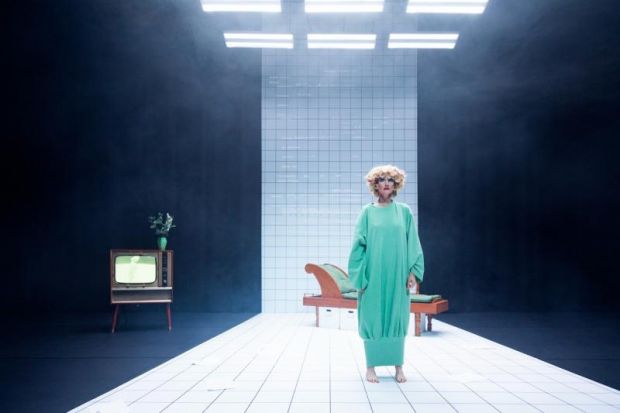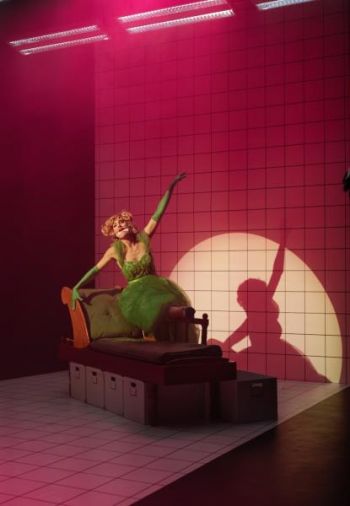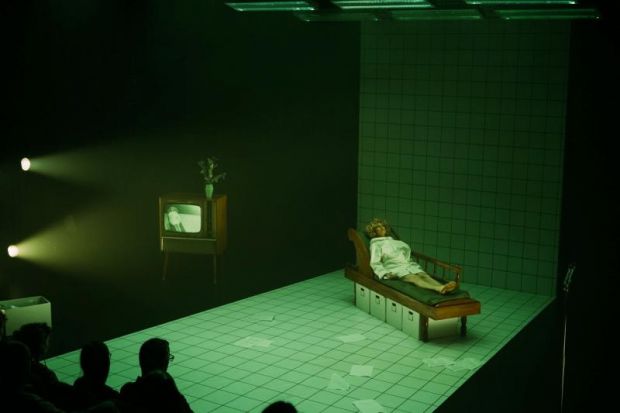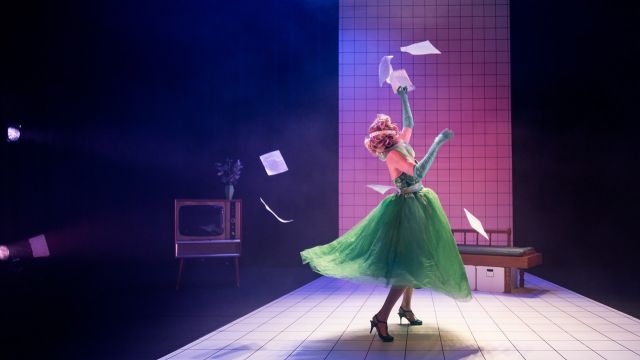Batshit
Leah Shelton’s Batshit, presented at Brisbane Powerhouse as part of Brisbane Festival, is a fearless, darkly comic excavation of how women’s emotions, desires, and dissent have been pathologized across history. Created in collaboration with co-writers Ursula Martinez and Christine Shelton, the work sits at the intersection of personal memoir, cultural critique, and theatrical innovation, resulting in a performance that is as entertaining as it is intellectually and politically charged.
At the centre is Shelton herself; a creator, performer, co-writer, costume designer, and set co-designer whose virtuosity is astonishing. Across fifty tightly-woven minutes she sings, dances, acts, narrates, and shifts emotional registers with seamless precision. Shelton’s charismatic presence ensures that the audience is never less than riveted: her timing sharp, her physicality expressive, and her vocal tones resonant. She has that rare quality of being both intensely watchable and profoundly relatable, often coaxing laughter from us at the very moment she is dismantling something deeply unsettling.

The script is both superbly structured and rigorously researched, balancing historical insight with contemporary resonance. Voiceover, music, and video footage is woven into the narrative with a Brechtian sensibility, foregrounding the mechanisms of representation without descending into flashy ornamentation. Considering the subject-matter, the script doesn’t weigh too heavily on the audience. Those Brechtian elements and the comedy definitely support a level of emotional distance that makes the difficult more palatable for a viewer.
In Shelton’s hands, humour becomes a scalpel: disarming, incisive, and necessary for piercing through the weight of inherited trauma. The show is candid about its personal stakes (Shelton’s grandmother Gwen was institutionalised in 1960s Australia) yet it never feels self-indulgent. Instead, it offers a collective provocation, particularly poignant at a time when women’s rights remain precarious, and our mental health system continues to falter.

The production design is cohesive, deliberate, and deeply effective. Grace Uther’s video design, blending archival gems from Australian television with freshly minted satirical content, provides both texture and comic relief. Kenneth Lyons’ sound design, meanwhile, is restrained, precise, and flawlessly balanced, ensuring the production’s sonic world supports without overwhelming. Costume and make-up choices add another layer of wit and poignancy. The hospital-gown green colour palette, the exaggerated wig, and the absurdist prosthetic arms all oscillate between hilarity and discomfort, underlining the absurdity of the systems Shelton is critiquing.
The set, co-designed by Shelton and Freddy Komp, is stark and institutional, its tiled central panel dwarfing Shelton and reinforcing her character’s isolation. The chaise oozes warm, mid-century style while also adhering to the green colour scheme. The white archive boxes bursting from beneath further enhance the clinical coldness of the space. Cleverly concealed crawl spaces within furniture allow for startling special effects, amplifying moments of horror and helplessness.
Jason Glenwright’s lighting design punctuates the action with stark white washes, ominous shadows, and dynamic spotlights, particularly effective in sequences of physical duress—whether it be electroconvulsive therapy or the uncanny image of Shelton disappearing into the furniture. Freddy Komp’s live-feed and interactive video work is another highlight, the choice to have some broadcasts through a set piece resembling a 1960s television is an ingenious nod to both domesticity and the mediated images that have shaped cultural notions of “female madness.”
Direction by Martinez is taut, playful, and unflinching, guiding Shelton through tonal shifts with clarity and confidence. The dramaturgical shaping (with input from Saffron Benner) ensures the piece maintains both its intellectual heft and its emotional immediacy, while choreography by Kate Harman adds period-appropriate flair and further showcases Shelton’s formidable physical skills. Even the intertextual layering of pre-recorded and live voices—from Hugh Parker’s voiceovers to Naomi Price’s perky vocals—feels meticulously chosen and thematically resonant.

What stays with you after Batshit is not just its theatrical ingenuity, but its emotional impact. There are moments of genuine unease, moments where the laughter catches in your throat, and moments where the sheer humanity of the story breaks through with quiet force. It is touching, provocative, and yet ultimately uplifting entertainment, and a reminder that even as the systems that sought to silence women remain disturbingly present, so too does women’s resilience, creativity, and capacity for joy.
Batshit is a triumph of form and content, propelled by a powerhouse performance from Leah Shelton and realised through an outstanding team of collaborators. For theatre-makers, it’s a masterclass in how design, dramaturgy, and performance can align to create a work that is politically urgent, emotionally resonant, and artistically exhilarating. For audiences, it is unmissable.
Kitty Goodall
Photography by Pia Johnson (top two images) and Cecilia Martin Photography (lower two images(.
Subscribe to our E-Newsletter, buy our latest print edition or find a Performing Arts book at Book Nook.

